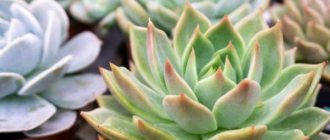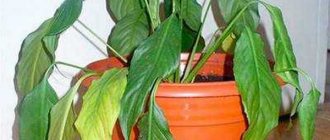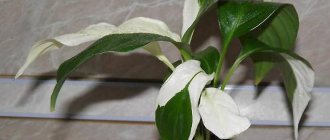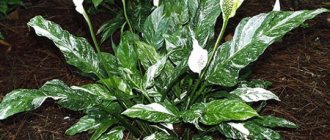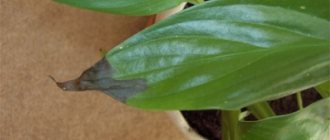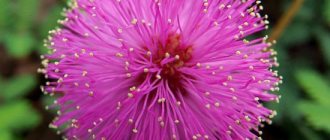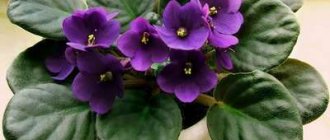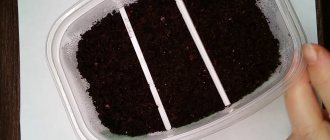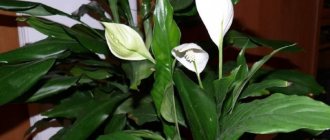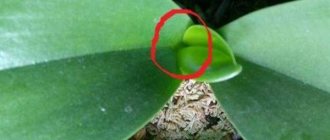Plant varieties with photos
It is important to know that the red color covering the inflorescences of the flower of female happiness is an unnatural phenomenon. The white color turns red due to the chemicals that are introduced into the plant.
What are the names of spathiphyllums that have scarlet inflorescences? Their name is anthuriums or “male happiness”. Below are the varieties of anthurium and photos of them.
Dakota
The most popular species among gardeners . It stands out from all the others thanks to the rather large size of the inflorescence covers - 14 - 23 cm. Spectacular flowers of bright color combined with lush dark green leaves simply cannot be ignored even in a spacious room.
Next is a video about the Dakota variety:
Minnesota
Their distinctive feature is the bracts of a rich scarlet color and the cobs, which are white at the base, gradually turning into bright yellow, sometimes green.
Red
This variety includes many types of anthriums that have very rich bright red or pink covers (for example, Edison).
Dark Red
Their color palette includes all shades from bright red to brown and even black. Burgundy and crimson colors look especially impressive .
Next is a video about the Dark Red variety:
Black queen
Against the background of the almost white spadix, the bract looks almost black. Against a dark background, all the veins stand out very clearly, which makes its appearance even more attractive and impressive.
Next is a video about the Black Queen variety:
Description of the variety
Sometimes you can hear that nurseries offer spathiphyllums with red or pink bracts. However, before you succumb to a tempting offer and rush to purchase a rare flower, it is worth understanding the classification. The white cover of a flower can only become colored under the influence of chemicals artificially introduced from the peduncle.
Important! Under natural conditions, the bract can only turn green.
And yet there are plants that are closely related to spathiphyllum and have colored perianth. These are anthuriums well known to gardeners. Thanks to breeders, depending on the variety, they are able to please the owner with scarlet, burgundy, pink and almost white covers of inflorescences. Spathiphyllum and anthurium have many common morphological features. Therefore, in the West, the common name is applied to plants - peace lily.
History of breeding
The legend of the red spathiphyllum originates in Colombia . The bloodthirsty leader of the tribe noticed a bride from another tribe, but she refused him, and then he ordered his servants to ruin the village and bring the poor girl to him by force.
On the wedding day, the proud girl threw herself straight into the fire in a beautiful red dress as a sign of protest. The gods, seeing this, turned her into a beautiful graceful anthurium.
In Colombia, there is a belief that red spathiphyllum can bring happiness to newlyweds.
Features and differences from other types
The main difference between red spathiphyllum (anthurium) and other species is the bright red color of the bracts , and the color of the spadix can be white, green and bright yellow. To the touch, the inflorescences of “male happiness” are somewhat harder and denser than those of other species. Also, in anthurium the smell is more pronounced, it can be pleasant, light, and sometimes smelly.
We have prepared a lot of materials about the types of spathiphyllums such as: Silver Cupido, Chopin, Domino, Sweet Chico, Alana, Sensation, Strauss, Wallis, as well as about white spathiphyllums.
Flower care at home
Lighting
It is best to place the anthurium on western or eastern window sills, where sunlight is diffused and in sufficient quantity. Despite the fact that this plant is a shade-loving plant, it will not be able to grow in complete darkness.
Temperature
Like any spathiphyllum, anthurium, which is its variety, does not like drafts and low temperatures.
It's all because of the tropical climate where it came from. In winter, during the rest period, the temperature should not fall below 15 degrees , and in summer it can be raised to 28 degrees. In winter, in order to avoid dehydration of the plant, it is better not to place it in close proximity to batteries.
Mainly, due to its unpretentiousness, the flower tolerates different temperature conditions in the room well.
Humidity
The humidity in the room should be as high as possible, and air humidifiers or, more conveniently, a pot placed in a flower pot, the remaining space of which is covered with expanded clay filled with water, will help ensure its sufficient level.
Anthurium, unlike spathiphyllum, is not recommended to be sprayed, because water often leaves a white coating on its leaves and covers. Instead, you can wipe the plant with a sponge or cloth, and sometimes use a shower without any drops of water getting on the bracts. After this procedure, you need to collect moisture from the plant with napkins or a dry cloth.
Watering
The main rule when watering anthurium is to water only when the top layer of the substrate in the pot becomes dry. As the room temperature decreases, the amount of water and frequency of the procedure decreases.
Top dressing
During the growing season (spring and summer), red spathiphyllum is fertilized once a week with mineral fertilizers or universal fertilizers (for aroid plants). In winter, fertilizing should not be done at all .
Transfer
Plants that are not yet five years old are replanted annually to change the pot to a larger one and the soil to more fertile one. After five years, this should be done every 2 to 3 years.
- During the procedure, it is necessary to inspect the roots for rot or other damage. If there are any, you need to cut off the damaged parts and sprinkle the cut areas with activated carbon.
- A drainage layer must be placed at the bottom of the new pot, which will not retain too much moisture.
- Next, an earthen ball with roots is placed on the drainage and sprinkled with earth.
- At the end you can add a small amount of water at room temperature.
Important! A small pot will stimulate flowering, and a slightly larger pot will stimulate the formation of shoots for propagation.
We offer for viewing a visual video about transplanting red spathiphyllum (anthurium):
Reproduction
- Red spathiphyllum can be propagated by dividing the rhizome of an adult plant into several parts or using shoots.
These are two similar methods that are very popular among gardeners because they are very simple. The rhizome must be removed from the pot, washed from the soil and divided into parts, each of which is placed in a separate container, smaller than the pot of an adult plant. - Rooting a piece of stem with a leaf, which is placed in a container of water until it takes root. Next, it needs to be planted in a small pot as an independent plant.
- Propagation by seeds.
This is the most difficult method of propagating anthurium. In the first three days of flowering, you need to pollinate the plant yourself: run a piece of cotton wool or a soft brush along the stem, this should be done 2-3 times over several days. After this, berries should form on the cob, which will ripen for almost 9 months. As soon as they ripen, they need to be planted immediately, as they quickly lose their viability. Shoots should appear in 7 – 14 days.
Reproduction of spathiphyllum
Decorative tropical beauty reproduces by division. During transplantation, in the spring, small young shoots are separated from the main bush and transplanted into a separate flower pot. To prevent the plant from thickening, it is advisable to carry out the procedure every 2-3 years.
The transplantation process is not complicated and does not require much effort from the grower. The substrate is slightly soaked. The flower is completely removed from the pot. The roots of the plant are cleaned of dry or infected particles, and a small amount of charcoal is applied to the cuts. Small shoots are separated from the flower. Each new seedling must have at least 2 flower rosettes and part of the root system. Drainage is placed at the bottom of the pot, a new plant is lowered, covered with soil mixture, and compacted. After transplanting, you need to water the flower.
With proper and minimal but regular care, spathiphyllum grows quickly and delights with its flowering all year round. A well-groomed plant will decorate your home, attracting the attention of guests.
Pests and diseases
The appearance of pests or gross violations of the conditions of keeping red spathiphyllum can lead to a deterioration in its appearance and internal condition.
- The infectious disease steptoria is caused by a fungus that prefers humidity and warmth, and because red spathiphyllum prefers just such conditions, it is very vulnerable. The fungus appears as brown spots and a yellow rim along the edges of the leaves. Gradually the leaves dry out and fall off. During this time, treating the plant with a fungicide will help save it.
- Powdery mildew causes the plant to quickly wither and develop black spots on the leaves, which spread when the anthurium is sprayed.
- If the watering regime of the anthurium is violated, rotting of the roots or wilting of the flower may occur (depending on the excess or lack of moisture in the substrate). The plant is more sensitive to the first.
- Lack of lighting causes the leaves of the flower to darken, and excess lighting causes them to yellow and fall off.
- Paleness of the leaves can be caused by improper feeding.
If there is weak plant growth and the absence of new inflorescences for a long time, this means that the plant does not have enough nutrition. If only wilting is present, then fertilizing should be reduced.
We offer a video about diseases and pests of anthurium:
Why does spathiphyllum not bloom?
It often happens with various indoor plants that they seem to look healthy and lush, but flatly refuse to bloom. This suggests that the growing conditions are not entirely suitable. This is also true for spathiphyllums.
The plant may receive too little or, conversely, too much light. Or the soil lacks the necessary microelements, and fertilizing is not done. Flowering does not occur if the air temperature is too low, or if the plant is planted in a pot that is too spacious: the bush will begin to form inflorescences only when it has wrapped its roots around the entire earthen ball. You can speed up the appearance of flowers when caring for them at home by transplanting the plant into a smaller pot.
It must be borne in mind that replanting a plant in itself is stressful for it, and it will take some time for it to adapt to its new “home.” Because of this, flowering may be delayed.
Similar plants
There is another flower that is similar in appearance to anthurium - calla lily. It has the same dark green lush leaves, bright ears and large spathes, which can be of various colors: yellow, white, pink, purple, lilac. Their main similarity is that bracts of this shape can take on the most unusual colors.
Red spathiphyllum (anthurium) is the most unusual indoor plant due to the abundance of color shades that the bract can take on. But at the same time, the plant requires no more attention than an ordinary spathiphyllum. It is only important to remember that anthurium juice is very poisonous, and therefore it must be handled with extreme care.
Are there red spathiphyllums? How to get this color from a plant yourself?
Many flower growers have probably heard that when nurseries mention the word “spathiphyllum,” they offer the buyer not the classic white version of this houseplant, but a red one. But before you succumb to such an interesting offer and quickly reach for your wallet, it’s worth understanding what the red version of spathiphyllum is.
Does spathiphyllum come in scarlet color?
In the original version - no. In nature, this flower has white or cream flowers and can only turn green. The red blanket appeared in a string of varieties of “female happiness” (why is spathiphyllum called that?) artificially using coloring with special chemical compounds.
Interesting! However, in nature there are still plants that are close relatives of spathiphyllums, and at the same time have a red (pink) tint of bracts, such as anthuriums (“male happiness”). Almost the same as spathiphyllums, only in red and other bright shades. They are the ones who can please flower growers with various shades of red, burgundy, and pink in the perianths.
Below is a photo of a scarlet “female happiness” flower.
Residents of a house where such bright spathiphyllums grow will always have a good mood and positive emotions.
What are the names of plants that are often confused with it?
It has already been said that red artificially bred spathiphyllums are often confused with anthuriums . Despite the external similarity, these plants still have a lot of differences:
- the color of anthurium bracts can be bright red, burgundy, pink (almost white), green and bright yellow, and all these shades are natural for it;
- anthuriums have a more pronounced smell of flowers, sometimes it can be light and barely perceptible, and sometimes it can be too smelly and cause a headache;
- the inflorescences of “male happiness” are tougher and denser than those of other related plants.
But in addition to anthuriums, there is another species that can be mistakenly mistaken for an artificially bred red spathiphyllum - calla . It has the same dark green wide and lush leaf blades, rather bright ears and large bedspreads that can have many shades:
- yellow;
- white;
- pink;
- purple;
- lilac.
Red calla:
But still, the shape of the leaf blades and the flowers themselves give away this plant, so an experienced eye will immediately determine that this is a completely different species.
How to get this color yourself?
It is possible to get a red variety of spathiphyllum from a white flower, but it will be quite difficult. Almost nothing is known about the coloring of spathiphyllums, since color changes are mainly done by professionals. But if the desire to experiment with the plant is great, you can also try painting the spathiphyllum red, based on the techniques that are used to color roses, dahlias and other flowers.
For coloring you will need:
- special coloring mixtures that are sold in almost any flower shop;
- a vessel with water at room temperature;
- sugar – 1-2 teaspoons;
- white spathiphyllum.
Staining procedure:
- Dissolve the purchased dye in water.
- Remove the plant along with the earthen lump from the planting container.
- As carefully as possible, so as not to damage the sensitive root system of the plant, separate it from the soil.
- Immerse the roots in a container with dye for 8 hours.
There is a second method, which is less likely to help color the spathiphyllum in the desired shade. Instead of soaking the root system in the solution, you need to use watering with dye dissolved in it. The effect will not be as bright, but still noticeable.
Does artificial coloring harm the plant?
Whether there is any harm from such artificial coloring cannot be said for sure. Numerous experiments with different plant varieties did not reveal any negative effects . The plant's immune system was not affected.
Artificially colored red spathiphyllums have the same good health as their white and cream brothers.
Coloring flowers should be done only with special dyes purchased at a flower shop or, as a last resort, food dyes. No enamel, oil or other types of paints!
The red variation of spathiphyllum is an invention of a florist, a decorative invention. In addition to its primary decorative functions, the plant also performs the function of purifying the air from benzene vapors and other harmful compounds that can poison your lungs in the apartment.
Whether to believe the legends that spathiphyllum really brings happiness to the house is a personal matter for everyone (we wrote more about popular beliefs here). But the fact that this plant will decorate any apartment or flower garden is worth believing even in words. This elegant and bright plant will suit any interior.
And now, when it was possible to artificially obtain a red variety of spathiphyllum through dyeing, composing compositions from these plants has become even more exciting and interesting. So don't think too much about the purchase, it's worth it.
